
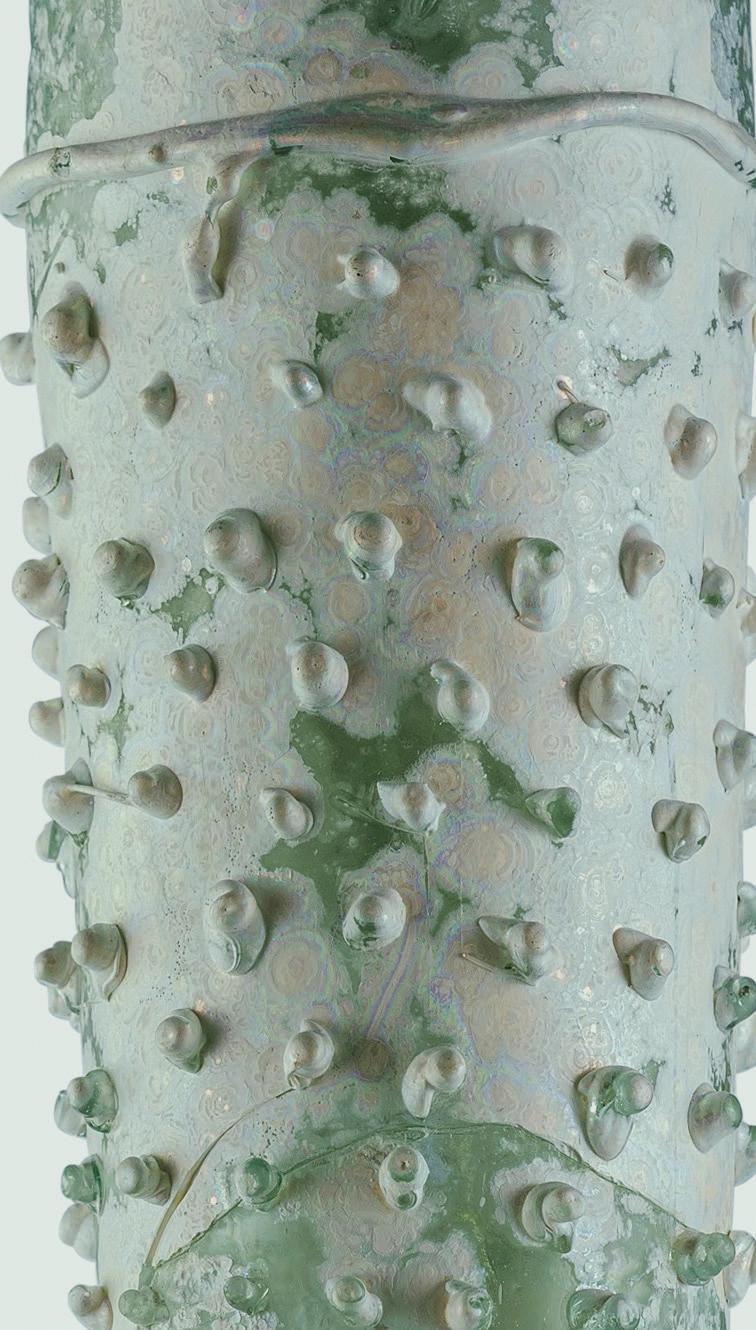

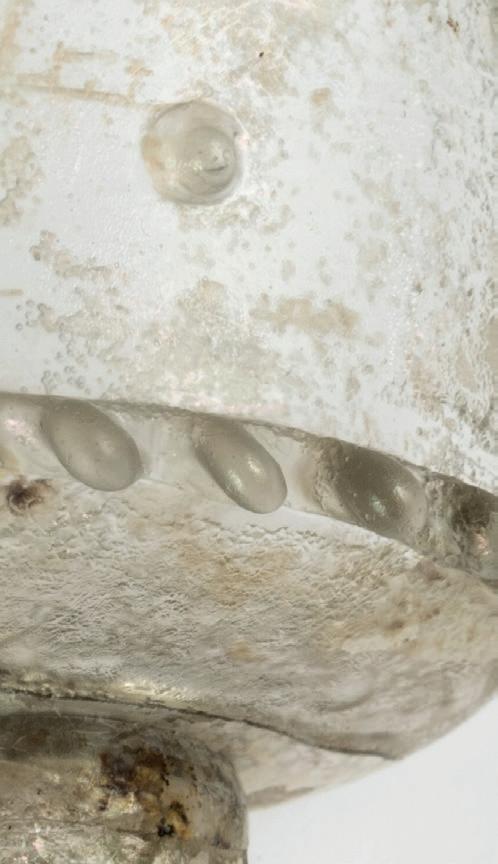


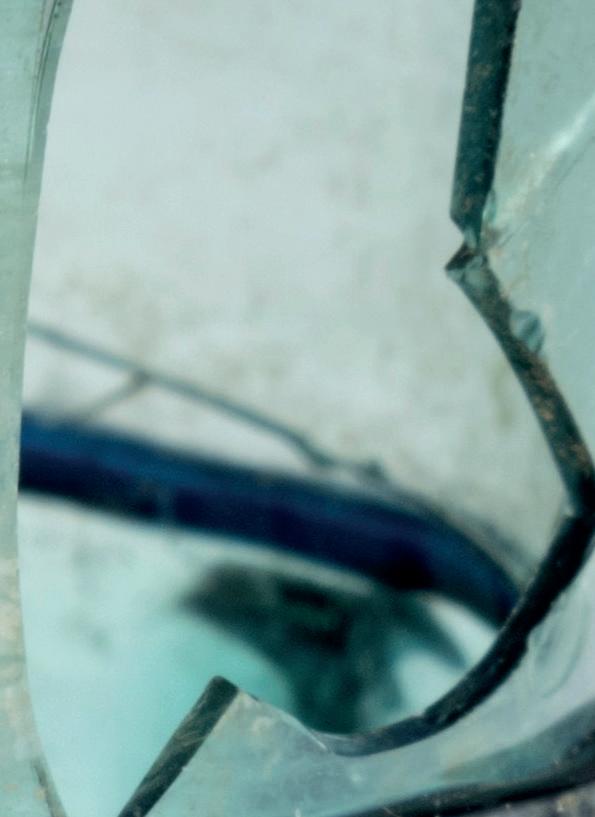


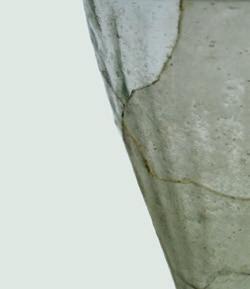

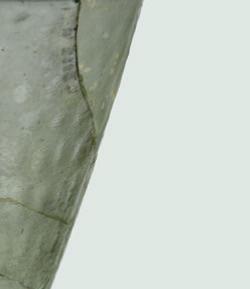

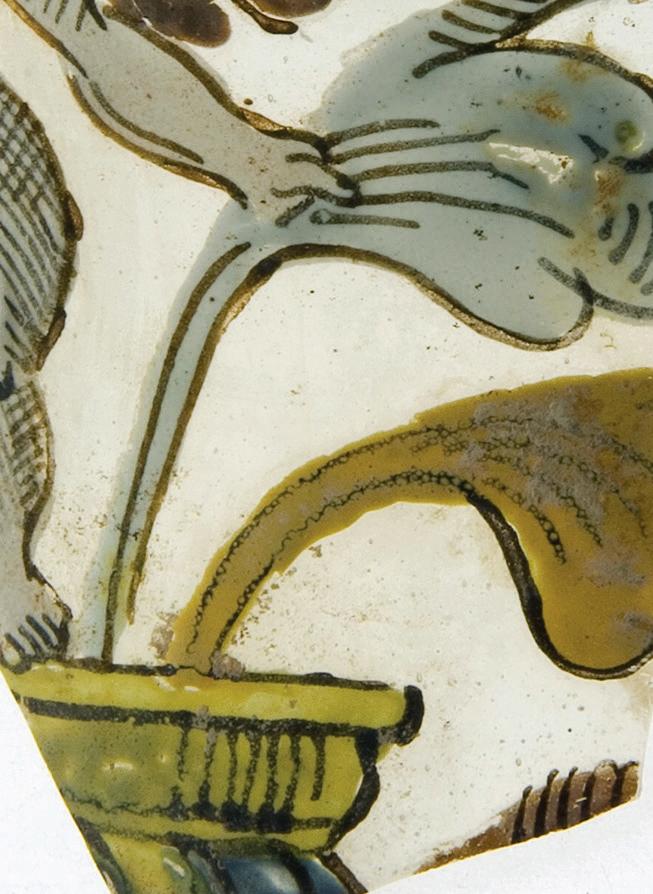
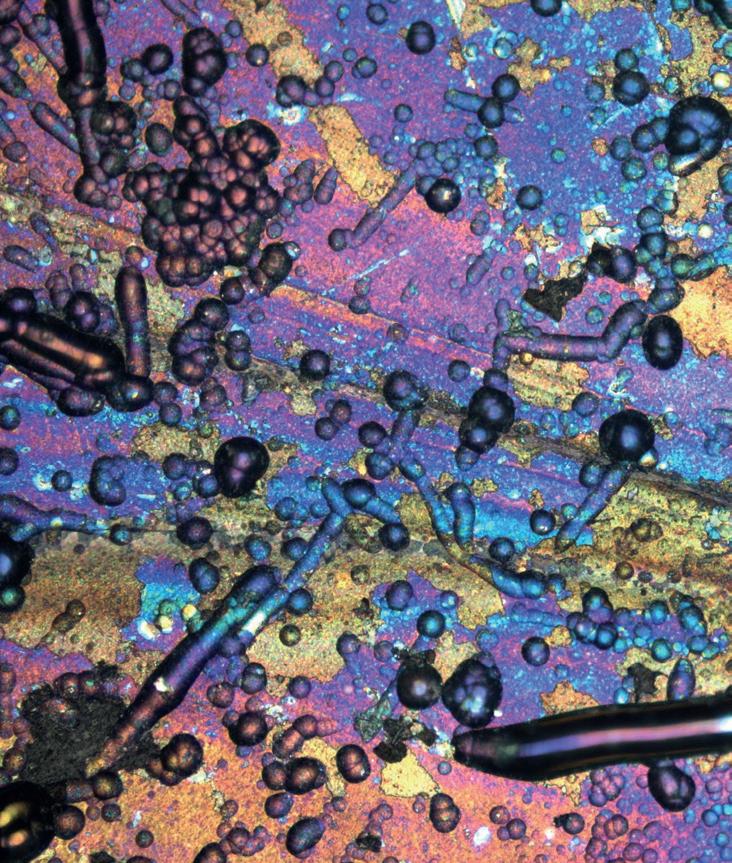

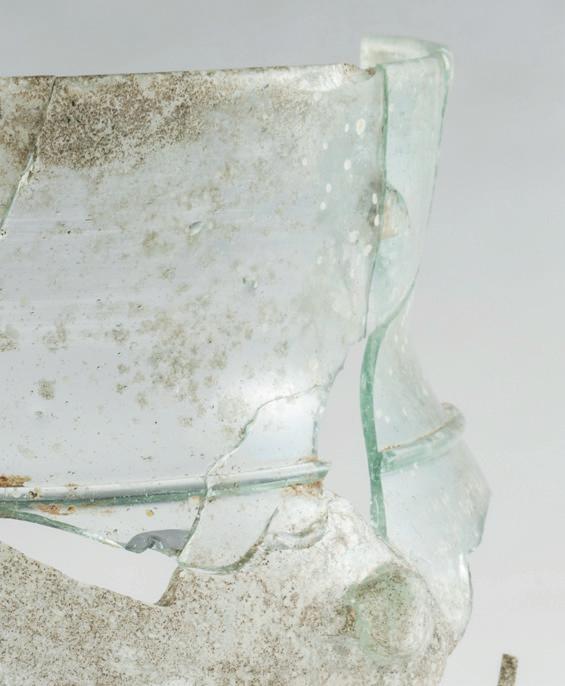
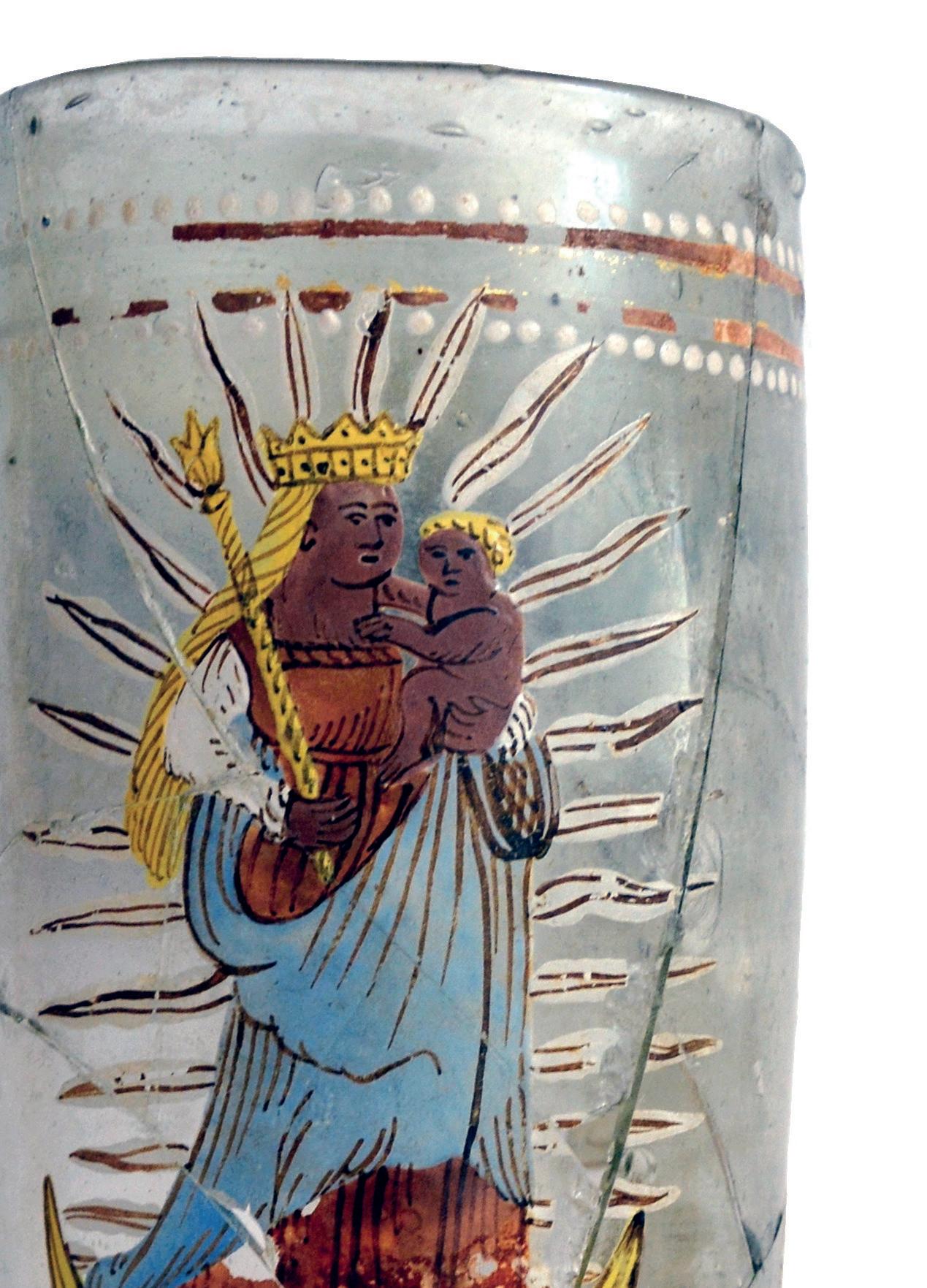
REGIONAL GLASS PRODUCTION AND IMPORTS IN CENTRAL EUROPE IN THE 13TH–18TH CENTURIES



PART II: CHRUDIM
DANA ROHANOVÁ et al.



















REGIONAL GLASS PRODUCTION AND IMPORTS IN CENTRAL EUROPE IN THE 13TH–18TH CENTURIES



PART II: CHRUDIM
DANA ROHANOVÁ et al.
Jan Frolík
Jan Musil
Dana Rohanová et al.
Book was created as part of the project „Glass in the Czech lands from Gothic to Baroque according findings from Chrudim and Brno. The importance of regional production in the European context“ supported by the Czech Science Foundation, number GA 19-05677S.
Pardubice 2023
Regional Glass Production and Imports in Central Europe in the 13th–18th Centuries
Part II: Chrudim
Book was created as part of the project „Glass in the Czech lands from Gothic to Baroque according findings from Chrudim and Brno. The importance of regional production in the European context“ supported by the Czech Science Foundation, number GA 19-05677S.
Peer Reviewers: Rudolf Krajíc, Irena Loskotová
Translation: Jan Frolík, Irma Charvátová, Tomáš Mařík, Jan Musil
Drawings: Jan Frolík, Olga Hartmannová, Barbora Hlaváčová, Karla Holínková, Pavlína Jakubková, Jan Musil, Michaela Rohlenová, Michaela Sedláčková, Kateřina Vaďurová, Valérie Uramová
Photographers: Jan Frolík, Martin Frouz, Olga Hartmannová, Jan Musil, Karolína Pánová, Kateřina Vaďurová, Jana Vepřeková
Layout: Lukáš Vavrečka, Boris Dimitrov
Publisher: University of Pardubice (Studentská 95, 532 10 Pardubice, IČO 00216275)
© University of Pardubice, 2023
© Jan Frolík, Martin Frouz, Aleš Helebrant, Daniela Ježdíková, Jan Musil, Karolína Pánová, Dana Rohanová, Michaela Sedláčková, Kateřina Vaďurová, Jana Vepřeková
Pardubice 2023
ISBN 978-80-7560-490-3 (tisk)
ISBN 978-80-7560-497-2 (pdf)
(Jan Frolik, University of Pardubice; Dana Rohanova, University of Chemistry and Technology, Prague)
I. Introduction
(Jan Musíl, University of Pardubice) 1.
2.
3.
4.
5.
II. Catalogue. Filištínská Street, Houses No. 37/I–40/I
1.
3.
(Jan Frolik, Daniela Ježdikova, University of Pardubice)
and preconditions of
No. 38/I
4. House No. 39/I
5. House No. 40/I
III. Catalogue. Hradební Street, Houses No. 10/I, 14/I and 15/I
(Kateřina Vaďurova, Archaia Brno z. ú.; Jan Musil, University of Pardubice)
1.
2.
3.
4. House No.
5.
IV. Chrudim – Evaluation of the Glass Findings
1. Chrudim – Filištínská Street, medieval glass and its shapes
(Jan Frolik, University of Pardubice; Jana Vepřekova, Regional Museum Vlašim)
2. Chrudim – Hradební Street. The change of the range of glass products in the households from the Middle Ages to Early Modern period
(Kateřina Vaďurova, Archaia Brno Company)
V. Chemical Composition of Glass
(Dana Rohanova, University of Chemistry and Technology, Prague)
1. The development of the glass composition and glassmaking technologies and the terminology used
2. Analysed glass from Chrudim, Filištínská and Hradební Streets, overview of glass types and their chemical composition
3. Gothic potassium-calcium glass from Chrudim (14th – first half of the 16th century)
4. Renaissance calcium-potassium glass from Chrudim (first half of the 16th century – last quarter of the 17th century)
5. Baroque glass from Chrudim and Central European finds (late 17th to mid-18th century)
6. Imported calcium-potassium glass, 12th–18th centuries
7. Experimental melting of historical glass
(Karolina Panova, University of Chemistry and Technology, Prague)
8. Manifestation of corrosion processes in archaeological glass
(Aleš Helebrant, Karolina Panova, University of Chemistry and Technology, Prague)
9. Chemical composition measurement and restoration work
VI. Glass and Archaeology: the Everyday Life in Individual Plots
1. Introduction
2. Filištínská Street
(Jan Frolik, Michaela Sedlačkova, University of Pardubice)
3. Hradební Street
(Jan Musil, University of Pardubice)
VII. Literature
Medieval archaeology has acquired large collections of Gothic, Renaissance and Baroque glass in recent decades. The assessment of the role of this commodity in the medieval household has completely changed. In addition to the study of the distribution and typology of vessels and other objects, their chronological classification and traces of production procedures, attention was focused on the use of glass in individual households of medieval townspeople and the methods of obtaining it. For the project, where this book is one of the outputs, places on long-distance roads (Brno, Chrudim, Wrocław) were chosen, where it was assumed that glass was also a trade commodity.1)
Rescue archaeological research has been carried out since the 1980s in Chrudim (East Bohemia). The largest wellstratified collections of finds were obtained during research in Filištínská Street (1996–1997) and Hradební Street (2006). Together, they encompassed seven house plots, i. e. 5 % of their number in the historic core of the city. They provide a detailed view of the daily life of a Chrudim burgher in the 13th to 17th centuries. An important part of the finds, especially from cesspits, is glass, representing the largest collection from eastern Bohemia. It provides a suitable opportunity for comparison with other towns and their glass collections in addition to witnessing daily life and its transformations over the course of several centuries. The location of Chrudim on an important road connecting Bohemia with Moravia (Trstenická trade route) allowed consideration of a possible trade in glass and the illumination of contacts with more distant or closer regions.
The research in Filištínská street, which included the backyards of four house plots on the edge of the city core, was carried out in cooperation with the Institute of Archaeological Heritage Care of Central Bohemia and the Museum of Eastern Bohemia in Hradec Králové. The research in Hradební Street, covering three house plots, was provided by the Institute of Archaeology of the Czech Academy of Science, Prague, and by the Regional Museum in Chrudim.
A large number of people, now mostly anonymous, participated in the field work and in the evaluation of a diverse set of findings from both excavations, to whom the authors are grateful. Among the archaeologists, special thanks go to Jiří Sigl, co-author of the research in Filištínská Street. Eva
Černá was the first to deal with glass from Filištínská Street,2) in Hradební Street there were Romana Kozáková and Lenka Klikarová.3) The students of the Institute of Historical Sciences of the University of Pardubice were also involved in the new detailed elaboration, some of them with an author’s share. Great deal of gratitude deserves the University of Pardubice, which undertook the publication of the Chrudim volume, after the scope of the results far exceeded the original assumption. Nor can we forget the Regional Museum in Chrudim, especially its archaeological department, which created the conditions for the processing of numerous glass fragments and for the patience with which it endured the resulting restrictions. At first glance, the large amount of restoration work carried out is not obvious. Students of the program: Conservation and restoration of art-historical works of glass and ceramics at UCT Prague literally brought archaeological vessels to life. From the mixture of broken and dirty shards, they patiently searched for vessels, cleaned them and carefully reconstructed their shape. So, in the photographs in the publication, we don’t have to look at parts of the sherds, but we clearly see the entire shapes of the historical vessels. Thanks to Romana Kozáková, Lenka Klikarová, Dominika Lukšíčková, Jana Fořtová, Petra Káďová, Tereza Malínková and others.
1) Project „Glass in Czech lands from Gothic to Baroque according findings from Chrudim and Brno. The importance of regional production in the European context“ (Czech Scientific Agency, number 19-05677S). Main project investigator was Archaia Brno Society, co-investigator Regional Museum in Chrudim.
Chemical analyses of glasses belong to essential information in determining the origin and dating of archaeological vessels and are certainly not 'decoration' of publications. When processing them, we focused not only on the comparison of the chemical compositions of the glasses, but mainly on the composition of the glass-batch mixture (ratio and quantity of raw materials used), which is a completely new approach. We calculated the individual glass batches from the knowledge of historically used raw materials and also verified them with laboratory meltings since glassmaking recipes were not preserved in written form (apart from Theophilus Presbyter’s recipe book from the beginning of the 12th century) until the Baroque period (Chapter V.7). It turned out to be the right way to reveal many ambiguities and long-held myths, to clarify the dating and origin of domestic and imported glass finds. We have inserted a text to orient the reader to the glassmaking and historical terminology used at the beginning of both volumes. In the first volume, which is devoted to Brno in comparison to Wrocław, right after each chapter, there is a chemical-technological view of glasses from the given period together with analogies of finds from other places. We also take a closer look at imported Italian soda-ash and German calcium-potassium glasses in the same volume, because Brno
2) Černá 2005.
3) Kozáková–Frolík 2011; Kozáková–Klikarová–Frolík 2010.
was abundantly supplied with them in the 13th – 15th centuries. In addition, the widely used Renaissance technology as well as newly emerging decoration techniques (painted and filigree glass) are described in detail. A separate chapter, as in the second volume, is devoted to Baroque glass. The chemical analyses of the glasses are presented in the second volume, dedicated to the finds from Chrudim in summary in Chapter V. We compare here the composition of Gothic Bohemian-type beakers, dozens of which were found in the cesspits (refuse pits) of Filištínská street, with finds of tall beakers from the entire region of Bohemia and Moravia. On the other hand, a large number of Renaissance goblets were found on Hradební Street, which is why attention is also paid to Renaissance technology. Furthermore, imported potassium-calcium and mixed glasses are described here, where their origin, chemical composition and the technology used were compared with glasses obtained from our foreign colleagues (Tyrolean Hall, the German cities of Dornsweg and Emsbach, the Hungarian Pomáz, Budapest and Visegrad, etc.).
The published data of glasses produced outside our region was the necessary source for comparison. The principles and causes of corrosion processes are briefly described on specific finds since archaeological glasses are mostly corroded (Chapters V.8 and V.8.1). Tables with chemical analyses of 384 glasses found in Brno, Chrudim and Wroclaw are inserted at the end of each part of the publication.
This publication would not have been created without the close cooperation of colleagues from many disciplines and institutions as is clear from the volume of archaeological, analytical and restoration work and photographic documentation (special thanks to Martin Frouz). We hope that it will be helpful to our fellow archaeologists and chemists, but also to historians and everyone who was fascinated by the sophisticated and hard work of ancient glassmakers.
Prague 18th May 2023 for the collective of authors Jan Frolík and Dana Rohanová
The picturesque East Bohemian town of Chrudim is the centre of an administrative district of the same name (1960–2002) forming since 2001 a part of the newly established Pardubice Region. After the abolition of the district department on 1 January 2003, Chrudim became a ‘municipality with extended competence’. On 31 December 2021, the built-up area measured 192.65 ha and counted 23,140 inhabitants. It is situated about 10 km south of the regional centre of Pardubice, 97 km east of the capital town of Prague, 103 km north-west of Brno and about 150 km south-west of the Lower Silesian centre of Wrocław and on the crossroads of important far-distance paths through the Labe Region towards Prague and the Trstenice Path towards Moravia and Central Bohemia. It was connected with Lower Silesia by a way leading through Hradec Králové, Jaroměř, Náchod and Kłodzko. (Fig. I/1) Regarding geomorphology, the described territory belongs to the relatively flat Chrudim table, a part of the Bohemian cretaceous table. In the north, it is delimited by the Labe valley; the south-western border consists of the Iron Mountains; in the south and south-east, it is the Vraclav ridge. The bedrock in this area consists of Middle Turonian sand, greywacke, mudrock and sinter sediments with clay layers in between. Chrudim is situated on a pronounced spur excavated by the meander of the Chrudimka River (in the Middle Ages called Kamenice) into a Tertiary gravel-sand terrace, covered with Quaternary loess winds on which fertile soils were formed since prehistoric times, predestining the local area for intensive agricultural activities. Branches and remnants of a system of water dams separate from the river, which in the Middle Ages and modern times powered numerous technical buildings (mills, sawmills, mounds, grinding mills, water pumps etc.). The actual area of the medieval town is located at an altitude of 260–272 m above sea level, i.e., its elevation compared to the river floodplain is 10–12 m. The urban core is surrounded by heights, Pumberky on the north-eastern side, Vlčí hora (Wolf Mountain) on the south-eastern side and Skřivánek to the west. Climatically, Chrudim lies in a warm to moderately warm climatic region, with an average annual air temperature of 8.2°C and an average annual temperature of 8–9°C. The described area belongs to snow area I, with an average annual cumulative rainfall of 599 mm. The direction of prevailing winds is westerly and south-easterly, the maximum wind strength is above 5° Beaufort, and the proportion of windlessness is 8.7%.1) The source of water
1) Balatka et al. 1987; Demek et al. 1965; Faltysová–Bárta et al. 2002; Jemelka ed. 1968; Válek 1964.


for direct consumption, the mild suitable climate and fertile agricultural land have formed the basic prerequisites for local settlement since the earliest times (Figs. I/2 and I/3). The favourable living conditions and the location at the crossroads of long-distance routes predestined Chrudim to develop central functions. It is therefore not surprising that from the beginning of the Late Stone Age we have to reckon with a highland settlement with a central function dominating the surrounding agrarian settlement. From the earlier Iron Age onwards, a hillfort was established on the site of today’s historic urban core, the eastern boundary of which extended further eastwards during the early Middle Ages (Fig. I/2). During the time of the Přemyslid princes, Chrudim became a so-called castle centre, which fulfilled a basic administrative and military function in the region. After the establishment of the medieval town, Chrudim became the centre of the region of the same name, bordering on the north with the Hradec Králové region, on the west with the Čáslav region, and
on the east bordering on historical Moravia. The Chrudim Region, which functioned until the 19th century, thus included most of the present Pardubice Region. The town was not only an administrative and political centre but also an important centre of education and culture. At the end of the 19th century, it earned the name ‘Athens of Eastern Bohemia’.2) The cultural and national development was also linked to the interest in studying the monuments of the ancient past and the establishment of the first institutions that began to collect and evaluate them. Unlike other royal cities in the region, Chrudim, like Hradec Králové, was fortunate to have preserved a tradition of archaeological excavations, which was followed by modern archaeological research. Over the last three decades, the number of archaeological excavations and finds has increased substantially thanks to the systematic monitoring of all construction activities in the town. The
2) Charvát 1991, 22–23.
establishment of an archaeological workplace at the Regional Museum in Chrudim in 2003 played a significant role in this. Large-scale archaeological excavations were carried out in the centre of the town and in the original medieval suburbs, which provided crucial information about the development of the settlement and the everyday life of the local inhabitants from prehistoric times to the present. The findings have been continuously published in professional and popular scientific monographs and articles. The local archaeological context can be compared with nearby Hradec Králové, which has not lost the continuity of archaeological research. Compared to Hradec Králové, however, Chrudim has one advantage, and that is the unique collection of medieval and modern glass from Filištínská and Hradební Streets.
Thanks to the financial support of the Grant Agency of the Czech Republic, No. GA 19-05677S (Glass in the Czech lands from the Gothic to the Baroque periods according to the findings in Chrudim and Brno: The importance of regional production in

the European context) it was possible to process this collection in an adequate way and make it available to the professional and general public. One of the main outputs of this project is therefore to make the extensive Chrudim collection accessible, including an expert evaluation of the largest East Bohemian collection of medieval and modern glass and its placement in a broader temporal and spatial context, especially its comparison with the Brno collections.
In order to process the research material, Vilém Walter (Archaia Brno, z. s.) created a database enabling the storage of typological and chronological information, as well as the results of analyses. The online database with a web interface employs the MySQL system. The data is stored in a triple-level hierarchy structure (site -» feature -» fragment), and each of these items can be assigned textual information and picture documentation, including further types of files. The sites contain geographical coordinates, which enables their direct viewing on the map. The database is part of the project and includes information for which there was not enough space in the publication such as descriptions of features and detailed photo-documentation of the finds.
Apart from the core team of researchers (Jan Frolík, Jan Musil, Dana Rohanova, Hedvika Sedláčková, Michaela Sedláčková, Kateřina Vaďurová and Jana Vepřeková), experts from Archaia Brno, z. s. took part in the project. Some of the project results have been published in studies and articles and presented at conferences and symposia in the Czech Republic. The text of the monograph is divided into six basic parts (Chapters I–VI). The introductory part (I) briefly outlines the archaeological and historical development of Chrudim from prehistoric times to the mid-18th century, the history of archaeological knowledge and everyday life in medieval and early modern Chrudim. The catalogue of glass finds is divided into two main parts according to the areas of extensive archaeological excavations in Filištínská Street (II) and Hradební Street (III). In the fourth part (IV), a typological and chronological evaluation of the finds of medieval and modern glass is made, and, in the fifth part (V), the results of chemical analyses are published. In the sixth and final chapter (VI), the medieval and modern glass is evaluated in the context of everyday life in the former royal town of Chrudim and all the findings are summarised and compared with other regions.
Chrudim is nowadays among the towns where, as a result of intensive long-term systematic archaeological research, a huge amount of archaeological knowledge has been obtained that has changed or significantly supplemented our ideas about the earliest history of the place. In this outline, we will focus our attention only on the historic core of the town, which coincides with the area of a distinctive tongue-shaped promontory protected on the north, west and south sides by the meander of the Chrudimka River, from which a system of water embankments emerges. The eastern side had to be artificially fortified. The earliest traces of the settlement of the Chrudim spur are evidenced by secondarily deposited fragments of pottery of the Neolithic Stroked Pottery culture.3) However, the appearance of the Neolithic settlement was completely wiped out by later interventions into the terrain. Already in the earlier stage of the Funnel Beaker culture there was an important upland settlement,4) which was the centre for several agrarian settlements on the cadastre of the present town. At the very end of the Hallstatt Period, a settlement of the Silesian-Platěnice culture was established here. In addition to the remains of a ditch and wooden fortification, a powerful cultural stratum with sunken features was discovered in several places, which provided a large number of archaeological finds.5)
Archaeological excavations have provided unequivocal evidence of the previously unknown existence of the hillfort in the Middle Hillfort Period, with the discovery of a rampart fortification of lattice construction and a spiked ditch.6) Information on the settlement within the fortified area was also obtained, as well as findings demonstrating long-distance contacts. Unfortunately, we do not have the necessary support in written sources for this period. The earliest indirect written mention of the Chrudim region can be found in the chronicle of Cosmas. Cosmas defines the dominion of Prince Slavnik in 981, and Chrudimsko was supposed to be a part of it.7) Unfortunately, we cannot trust its reliability to 100%.8) Another somewhat disputable reference is a charter granted to the Břevnov monastery dating back to 993. According to this,
3) Frolík 1981; 2001.
4) Frolík–Sigl 1998b, 14.
5) Frolík–Sigl 1998b, 16–17; Novák 2010; 2011; Musil 2012.
6) Frolík–Sigl 1998b, 21–22; 1999b; Frolík 2008; Musil 2012.
7) FRB II, 40.
8) See Sláma 1995; Šulc 2002, 2.
the monastery was to receive a share of the court fines. This charter is considered to be a forgery from the 13th century.9) The development continued smoothly during the Late Hillfort period. Even before the actual establishment of a fully institutional medieval town, Chrudim played a very important role in the administration of Přemyslid Bohemia. On the basis of archaeological sources, Chrudim can be classified as one of the important castle centres of eastern Bohemia since the 10th century at the latest. The local fortified settlement, situated on an important trade route, the so-called Trstenice Path connecting Bohemia with Moravia, was, like other centres in the region, included in the so-called castle system forming the administrative structure of the early medieval Bohemian state.10)
The first truly reliable written record of the existence of the Chrudim hillfort is the description of the circumstances of the death of Prince Břetislav I, also recounted by the chronicler Cosmas. According to Cosmas, the death of the Bohemian prince was explicitly stated to have taken place in the Chrudim hillfort (‘Hrudim in urbe’) on 10 January 1055.11) There are not many other written reports for Chrudim in the period before the town was founded. A donation by Vratislaus II to the Chapter of Vyšehrad is reported from 1088, but this is a later forgery from the first half of the 12th century.12) The next report filling the information vacuum left by Cosmas does not come until 1130. It is Soběslav’s confirmation of the tithe from the peace tax for the Chapter of Vyšehrad.13) Josef Žemlička14) is sceptical about this dating. The only more reliable written report covering the 12th century comes from the Canon of Vyšehrad, who mentions inhabitants from the Chrudim region as participants in the campaign to Poland in 1134.15)
The fortifications of the Chrudim hillfort were rebuilt and expanded at least twice during the 11th – first half of the 13th centuries.16) The impetus for the construction of the younger wall was a massive fire, which, of course, is not documented in written sources. Jan Frolík and Jiří Sigl17) offer the hypothetical possibility of an invasion of foreign armies heading to Bohemia along the so-called Trstenice Path, or of the end of the de-politicized fate. The intensive settlement of the
9) Pražák 1993; Žemlička 1993; see Šulc 2002, 2.
10) Žemlička 1978, esp. pp. 567–568.
11) FRB II, 86–87.
12) CDB I, 375, No. 387; but confirmed in 1222 – CDB II, 216, No. 2.
13) CDB I, 375, No. 387.
14) Žemlička 1997, 178–179; here a detailed analysis of the issue.
15) FRB II, 217.
16) See Frolík 2008; Musil 2012. 17) Frolík–Sigl 1998b, 25.
entire area is documented, and the findings indicate a log building. The layout of the early medieval fortification is still preserved in the ground plan of the town (see Figs. I/2 and I/3), and by studying it in detail and comparing it with the results of archaeological excavations, we can identify its original extent quite easily.18) The fortification was probably two-part. The acropolis proper coincides with the area of the High Medieval town enclosed in a ring of stone walls. The town of Chrudim was probably founded by Czech king Přemysl Otakar II in a favourable position above the Chrudimka River. Chrudim belongs to the so-called growing towns, which were founded on an older fortress foundation. From fragmentary indirect written records, it appears that it happened before 1276.19) In line with this, data obtained by dendrochronology (dating by means of year rings) from archaeological contexts that are clearly already related to the founded city provide dates ranging from ‘shortly after 1262’ to ‘shortly after 1274’.20) We are only minimally informed about the functioning of the town at the time of its foundation. As early as 1248, Přemysl Otakar II and Wenceslaus I had already adjusted the powers of beneficiaries and judges, among others, in Chrudim by the subjects of the Sedlec monastery.21) From the period when the town may have already been founded (1268) comes a mention of the Plebanus Conrad of Chrudim. He thus becomes the oldest known inhabitant of Chrudim, together with the locator of the same name, Konrad, documented in the text of a hypothetical foundation charter of the town, which, however, is preserved in the form of an incomplete copy in the form collection of Henry of Isernia.22) In 1289, Hradec Králové and Chrudim were to become the subject of a pledge in Wenceslas II’s attempt to acquire Meissen, but the transaction did not take place.23) From the very end of the 13th century (1295), there is a mention of Mikuláš, or Jan of Chrudim, a priest at the church of St. Vitus in Prague.24) This exhausts the written sources for the 13th century about Chrudim. Archaeology in particular informs us about the everyday life of the medieval town from the second half of the 13th to the mid-14th century. Chrudim is often mentioned among the dowry towns of Bohemian queens, which formed a specific group of our medieval towns. Dvůr Králové nad Labem, Hradec Králové, Chrudim,
18) Frolík 2009b.
19) Frolík–Sigl 2001, 620–629.
20) Frolík–Sigl 2001, 622.
21) Šulc 2002, note 31.
22) CIM II, 82–84, No. 24; RBM II, 1030–1031, No. 2380; see Kejř 1998; Šulc 2002.
23) RBM II, 632, No. 1467.
24) RBM II, 722, No. 1679.
Jaroměř, Mělník, Nový Bydžov, Polička, Vysoké Mýto, Trutnov are explicitly mentioned as dowries in the literature.25) To this day, it has not been established exactly when this institution first appears. There is no unanimity in the literature, so either the year 1305 or 1307 is given. Most contemporary scholars, however, lean more towards 1307, when Rudolf I of Habsburg bequeathed them to his wife Eliška Rejčka.26) However, there is no actual document confirming this act. The first reliable document dates back to 17 August 1308, when Eliška Rejčka confirmed the dower towns’ privileges.27) On 5 October 1307, the Roman king Albrecht of Habsburg issued a privilege for Chrudim, when Eliška Rejčka admitted his garrisons to her dower towns. From the 16th century onwards, however, it was more of a formal matter, which was mainly manifested by the fact that the queen was the patron of the local church; the transfer of the towns’ decree to the queen gradually became more of an administrative matter.
In the 1430s and 1440s, the town was granted a number of important privileges, which, in confrontation with archaeological evidence of a powerful fire, are considered evidence of the town’s renewal.28) In 1335, Chrudim came under a different legal system. According to the form text from the collection of Henry of Isernia, Chrudim was to be governed by the law of Jihlava after its foundation.29) According to the 1335 privilege, the town was to be governed by the law of the Old Town of Prague.30) Another important date was 1337. John of Luxembourg issued a charter weakening the influence of the royal vice-chamberlain, providing tax relief and the election of consuls.31) Following on from the previous acts, Charles IV’s privilege of 1348 exempted the town from customs duties and other fees in the subject towns, and in 1372 he issued an inheritance order which again strengthened the position of the local burgesses.32)
The reign of the Luxemburg dynasty was marked by the architectural transformation of the town, the oldest burgher stone architecture was built,33) the Church of the Assumption of the Virgin Mary was completed, and hospitals with the churches of the St. John the Baptist and St. Catherine were built. There is evidence of a Dominican convent with a church dedicated to the Virgin Mary. Already at the turn of the 14th and 15th
25) See Krsková 2001.
26) Heřmanský–Fiala eds. 1952, 262.
27) RBM II, 945, No. 2174; Šulc 2002, 4.
28) Frolík–Sigl 1998b; 2001; see Ježek 1999.
29) Ježek 1999; Kejř 1998.
30) Lábler 1900; Frolík–Sigl 1998b, 31.
31) RBM IV, 184, No. 442.
32) Frolík–Sigl 1998b, 39.
33) Frolík–Sigl 1998b, 40–44; Frolík–Musil 2014.
centuries, a town school was functioning.34) This period also saw a change in the nature of the municipal administration, with the gradual reduction of the authority of the town clerk, who ceased to preside over the town council sometime after 1363. His place is replaced by the mayor, as evidenced in 1395. The town council then gradually assumed decisive power in the administration of the town.35) The symbol of the town was, of course, the town seal. There are four seals from the 14th century, two of which have survived. However, only one of them can be dated more precisely, namely to the years 1362–1363.36) If we omit the torso of the oldest tax register from 1399–1402,37) the first surviving town register dates back to 1439. Thanks to the evidence of the oldest tax register, we know that Chrudim had 615 taxpayers in 1399–1402, i. e., about 3,000 inhabitants.38) Among the taxpayers, we find 300 names clearly German, 134 Czech-sounding and 142 unclassifiable.39) Among artisans, clothiers dominate (151 persons), butchers (41), maltsters (40) and bakers (33) are also numerous, and millers, fishermen, herring-makers, and pie-makers are also mentioned, gardeners, tailors, furriers, cobblers, goldsmiths, blacksmiths, shepherds, potters, carpenters, bricklayers, bell-ringers, stonemasons, knifemakers, tailors, sword-makers, painters, glaziers etc.40)
The events of the Hussite Revolution had a significant impact on the history of the town. At the beginning of the Hussite revolts, Chrudim sided with King Sigismund of Luxembourg, and the controversial Jan Městecký of Opočno became the regional governor. Jan Městecký’s actions against the Hussites of Přelouč and Chotěboř became the catalyst for a combined Hussite offensive into eastern Bohemia in April 1421. Part of the Hussite military contingent led by Jan Žižka occupied Chrudim, which surrendered on 28 April 1421. Jan Městecký capitulated and solemnly promised to defect to the Hussite side, which he soon broke. The local Dominican convent fell victim to the Hussite invasion, and the Catholic parishes were occupied by Hussite priests.41) Chrudim became a subordinate part of the Union of Prague, which appropriated all the income from the town that had previously belonged to the monarch. The town remained on the side of the Hussites until 1435, and only in 1437 was its dowry status restored.42)
34) Frolík–Musil–Richter–Vojtíšek 2016, 22.
35) Frolík–Sigl 1998b, 39.
36) Šášinková 1989, 14.
37) Frolík–Musil–Richter–Vojtíšek 2016.
38) Frolík–Sigl 1998b, 45; Frolík–Musil–Richter–Vojtíšek 2016, 20–22.
39) Frolík–Musil–Richter–Vojtíšek 2016, 20.
40) Frolík–Musil–Richter–Vojtíšek 2016.
41) Musil 2015a.
42) Frolík–Sigl 1998b, 39.
The period of the second half of the 15th and the first half of the 16th century was a time of the overall flourishing of the town, which was reflected not only in the new late Gothic and early Renaissance appearance of the town but also in the development and high level of the local town school closely linked to the Prague University. Older churches and chapels in the suburbs were rebuilt (St. John the Baptist, St. Catherine’s, the Exaltation of the Holy Cross), and the cemetery church of St. Michael the Archangel in the New Town suburb was newly built. When Matthias Corvinus invaded Bohemia in February 1469, the suburbs of Chrudim were probably burnt down, but the town itself was not conquered. Probably after 1473, a water tower was built in today’s Soukenická Street, and in the second half of the 15th century, we have evidence of the existence of a souk, a town slaughterhouse and a grinding plant. The self-confidence of the townspeople was also manifested in their participation in the struggle for the preservation of town privileges when in 1502 the town became part of the unity of 32 Czech royal towns defending their old privileges.43) The rise of self-confidence of the townspeople of Chrudim was also manifested at this time by the purchase of aristocratic estates in the vicinity of the town so that the town became in some places the dominion of the serfs. However, in 1546–1547 the town took part in the anti-Habsburg uprising and after its defeat it was hit by severe sanctions. The town was punished by the confiscation of all its property, the seizure of all its existing privileges, the payment of a fine of 1,000 schock groschen and the imposition of an extraordinary tax – the so-called ‘after-tax’ – on every barrel of beer brewed. In addition, a royal bailiff was temporarily appointed to oversee the town’s administration. This significantly undermined the economic strength of the town, leading to a certain stagnation of economic development during the first half of the 16th century. However, cultural development was not significantly affected. The period of the second half of the 16th century was marked by the reassertion of political and economic influence (Figs. I/4 and I/5). A significant reflection of these efforts can be seen in the numerous reconstructions of burgher houses and courts both in the inner city (e. g., the arcade in Štěpánkova Street or the so-called Mydlář House) and in the suburbs. As of 1567, 143 houses stood in the inner town and 342 in the suburbs, making a total of 485 houses. The size of the town’s population is estimated at approximately 3,000 people.44) The successful new economic boom of the town was sharply interrupted by the events of the Thirty Years’ War. The passage of troops from all warring sides, the city’s indebtedness,
43) Lábler 1900; Charvát 1991; Frolík–Sigl 1998b.
44) Klaus–Florián–Fiala 1926; Frolík–Sigl 1998b, 45.
general economic decline, numerous fires and the exodus of the entire non-Catholic population meant a catastrophe from which the city was still recovering throughout the second half of the 18th century. Chrudim joined the turbulent events of the Thirty Years’ War very early on the side of the Czech Estates. After their defeat on 8 November 1620 at the Battle of White Mountain, imperial commissioners arrived in Chrudim on 27 November 1620 to take the oath of allegiance from the town. According to the inventory from 1626, 36 families of exiles left the town and even 122 from the suburbs of Chrudim. Although a small part of the exiles returned or transferred their property to relatives, the damage was still immeasurable. The repeated Swedish invasions in 1639, 1643, 1645 and 1648, as well as the overwintering of ‘friendly’ military contingents, were a major blow to the town and its inhabitants.45) In the 1653 tax rule, 217 abandoned houses were registered, while only 1,100 inhabitants lived in the town itself. If we compare this with the situation as of 1567, it means the disappearance of almost half of the houses and the reduction of the town’s population to one third.46) By comparison, Chrudim reached the same demographic level as before the outbreak of the Thirty Years’ War only in 1785, as evidenced by the data of the Josephine cadastre.47)
The period after the end of the Thirty Years’ War was marked by very slow reconstruction and recatholization. The cult of Christ the Saviour played an important role in religious life, turning Chrudim into one of the most important pilgrimage sites in East Bohemia. The central object of worship was the miraculous image of Christ the Saviour, which is credited with, among other things, a significant influence on the reversal of the plague epidemics of 1680 and 1713.48) Another cultural factor was the monastery of the Capuchin order with the Church of St. Joseph, which housed the Loreto Chapel and the Holy Sepulchre. The emergence of these new centres of Baroque piety was accompanied by numerous crowds of pilgrims, thanks to which the city gained a considerable source of income, much needed for the overall reconstruction. The economic conjunction based on the wave of Baroque piety created the basic conditions for the functioning of high-quality sculpture and painting workshops, which made Chrudim an important centre of Baroque art. The Church of the Assumption of the Virgin Mary in today’s Resselovo Square was significantly ennobled, where the miraculous painting of Christ the Saviour was placed. The Capuchin Convent, located
45) See Musil–Netolický–Preusz 2018.
46) Klaus–Florián–Kudrna 1926, 228, 329–330; Charvát 1991, 20–21; Frolík–Sigl 1998b, 39.
47) Klaus–Florián–Kudrna 1926, 339.
48) Boček–Kobetič–Pavlík eds. 2018, 180.
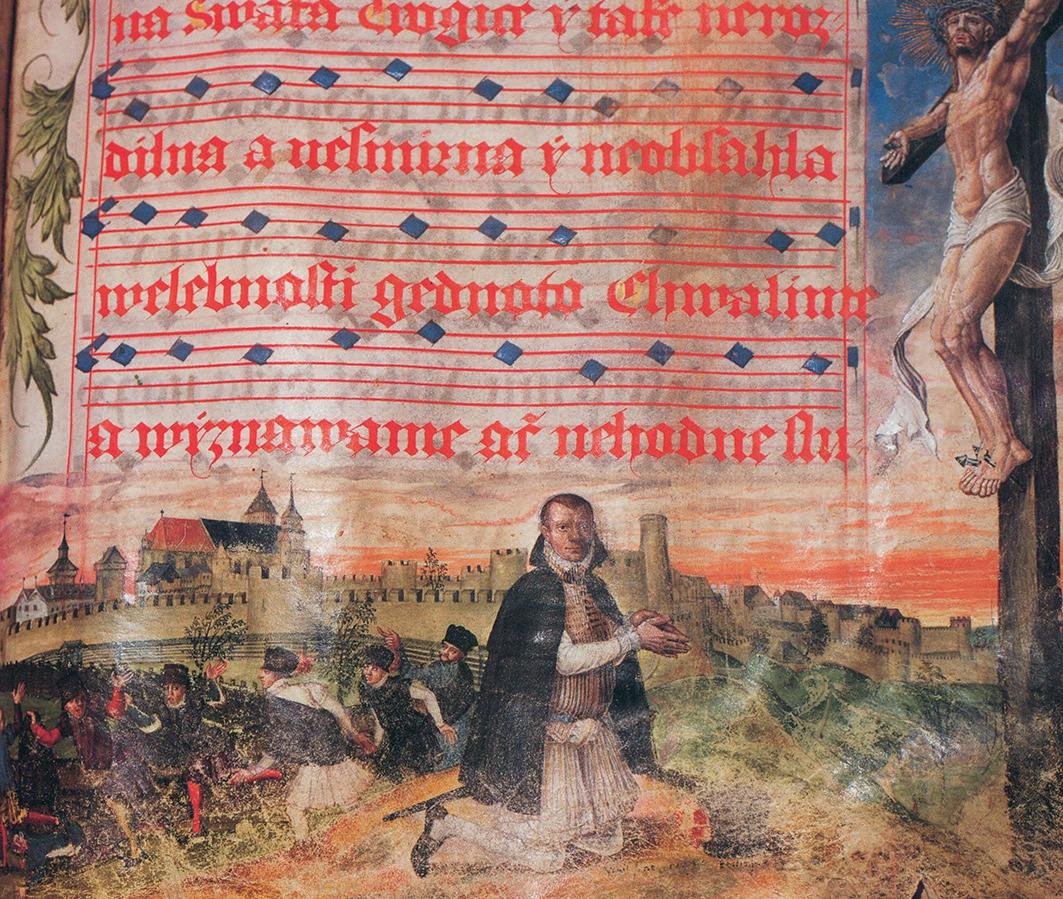

outside the city walls, was also mentioned. The column of the Transfiguration of the Lord from 1714–1732 became an important landmark. A significant economic disaster was the lost court case with Slatiňany upland, which caused the Chrudim municipality to lose a significant part of its forests in 1729, as well as the embezzlement of the town’s finances by the collector of the town’s counter-taxes. From December 1741 until May of the following year, Chrudim was occupied by the Prussian army of Frederick the Great. The town was briefly occupied again in 1744. The importance of Chrudim increased in the 1850s. In 1750, an important post office was established there, and in 1751 a new regional office was established in the town.49)
49) Charvát 1991; Boček–Kobetič–Pavlík eds. 2018.
The first archaeological report from Chrudim was published by Antonín Rybička-Skutečský.50) The most important figure of research in the 1850s–1860s was the commissioner of the sub-district court, Mořic Lüssner,51) who also worked in Hradec Králové. Despite his strong romantic background, his manuscript legacy52) and published reports53) are valuable sources of knowledge for the earliest history of Chrudim. Mořic Lüssner had an excellent talent for observation and his drawings (Figs. I/7 and I/17) and descriptions are today the only source of knowledge of situations that have already disappeared. In the 1850s, he saved a considerable number of archaeological monuments in Chrudim, during the construction of the regional courthouse, which was situated on the site of a defunct Dominican monastery before 1421. In addition, he was present during the construction of the gymnasium building on Školní Square and various smaller excavations in the area of the historic core. He also captured the still undisturbed situation at the Church of the Exaltation of the Holy Cross.
Mořic Lüssner’s work was continued by the city architect František Schmoranz. Their joint work on the site of the regional court (Fig. I/7) largely influenced Schmoranz’s later interpretations of the exposed archaeological contexts around the presbytery of the statically disturbed Church of the Assumption.54) Archaeological sources and their interpretation were later often used as supplements to the history of Chrudim.55) After the departure of Mořic Lüssner, the archaeological contexts were no longer systematically monitored. The only bright exception is the article by Antonín Šolta,56) the local curator of museum collections. The first summary of the archaeological sources and research to date was made by Josef Ladislav Píč.57) Píč’s work can then be echoed in the regional synthesis ‘Chrudimsko a Nasavrcko’.58) In the first half of the last century, isolated finds from Chrudim and its
50) Rybička-Skutečský 1848a.
51) Frolík 2011, 10–11.
52) Lüssner 1844–1890.
53) E.g., Lüssner 1857a; 1857b; 1858; 1858–1859; 1860; 1860–1861; 1864–1865.
54) Schmoranz 1873; 1877a; 1877b.
55) Adámek 1922; Klaus–Florián–Kudrna 1926; Vacek 1938.
56) Šolta 1898–1899.
57) Píč 1899; 1905; 1909.
58) Vepřek 1909; Klaus–Florián–Kudrna 1926.
surroundings were published by the town archivist Vincenc (Čeněk) Florián59) and the Hradec Králové archaeologist Ludvík Domečka.60) In the 1950s and 1960s, several rescue excavations were carried out by the staff of the Institute of Archaeology of the Czechoslovak Academy of Sciences in Prague.
Since the 1980s, Chrudim has been systematically monitored61) and all major construction projects have been archaeologically documented (see Fig. I/6). The first such action was the documentation of the linear excavation for the water supply and sewerage system in Široká Street, Ressel Square and Školní Square (Fig. I/6 –10),62) during which a cross-section of the entire historic core of the town was obtained. Minor excavations also touched upon the suburbs of Chrudim (Fig. I/6 – 2–4).63) After the rescue research in the static shafts in Štěpánkova Street (Fig. 1/6 – 6),64) survey research was carried out in No. 85/I in 1989 and 1990 (Fig. 1/6 – 7).65) Thus, an idea of the spatial development of one urban plot from prehistory to the present was obtained. In 1995, the site of the extinct house No. 59/I in Komenský Street (Fig. 1/6 – 12)66) and No. 14/I in Hradební Street (Fig. 1/6 – 23)67) were investigated. The most extensive rescue archaeological research up to that time was carried out in 1996–1997 on the site of the extinct houses Nos. 37/I–40/I in Filištínská Street (Fig. 1/6 – 22).68) In 1999 and 2000, remediation work was carried out at the site of the city moat on Všehrdovo Square (Fig. 1/6 – 26) and at the city walls circuit in Lázeňská, Soukenická Streets and at the Broad Steps (Fig. 1/6 – 15).69) In 2001, excavations were carried out at No. 7/I in Rybičkova Street (Fig. 1/6 – 21).70) Since 2003, an archaeologist has been employed at the Regional Museum in Chrudim. In 2004, a number of archaeological excavations were carried out in the town fortifications (Gunpowder bastion71) – Fig. 1/6 – 25; Filištínská Street, No. 26/I72) – Fig. 1/6 – 14; the first phase of the research on
59) Florián 1914.
60) Domečka 1929.
61) Frolík 1980.
62) Frolík–Sigl 1994.
63) Frolík–Sigl 1990a; 1996; 1997b.
64) Bláha–Frolík–Sigl 2004, 179–181.
65) Frolík–Sigl 1990b; 1991–1992; 1995b.
66) Frolík 1995.
67) Sigl 1995.
68) Frolík–Sigl 1997a; 1998a; 1998b.
69) Frolík 2001.
70) Rohlenová 2016.
71) Frolík 2009a.
72) Frolík 2004.